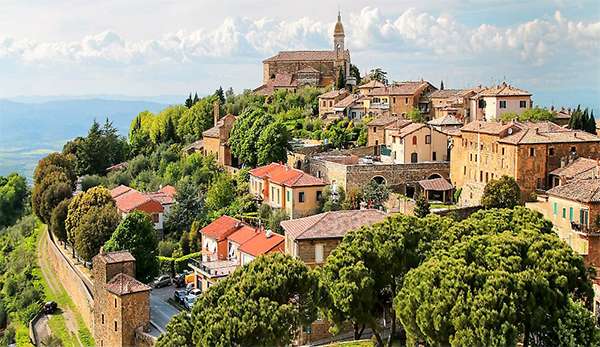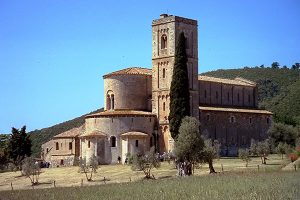Montalcino-Town of Montalcino

Montalcino
Uno di quei posti il cui nome è una garanzia storico-culturale è senza dubbio Montalcino, le cui origini si trovano scritte fin dall’anno 819. Partendo da Follonica si arriva nella Città del Brunello in circa 1 ora e mezza. La strada più breve è quella segnalata nell’itinerario del Monte Amiata e della Val d’Orcia, passando da Castel del Piano, Seggiano, Castelnuovo dell’Abbate, dove Sant’Antimo è tappa obbligata, per poi arrivare a Montalcino. Tutto, in questa splendida località ci parla di Storia, Arte e Cultura.
Lasciato il Monte Amiata appena si arriva in paese ci troviamo proprio davanti alla Fortezza. Una volta parcheggiato il mezzo si deve procedere a piedi altrimenti si perderebbe il meglio che si può osservare, a partire da tutti gli scorci panoramici, da ogni singola costruzione, dalla Torre di “Piazza Padella”, dalle numerose Chiese con Opere di Ambrogio Lorenzetti, Simone Martini, dei Della Robbia o della loro Scuola, tanto per citare qualche nome fra i più famosi. Che dire del Palazzo dei Priori, costruzione del 1200-1300 dove è insediato il Comune? La Sede di un circolo ricreativo culturale è in un palazzo del XIV/XV sec., perché le costruzioni del centro storico a Montalcino, sono quelle. Quindi le botteghe artigiane di un tempo le troviamo lì, fra il cotto senese, le travi a vista e le pietre del luogo. Così come troviamo anche quelle che artigiane non sono, ma i “fondi” commerciali sono rimasti giustamente invariati.
A Montalcino tutto è da vedere:
il Duomo che come alcuni Costruttori di edifici sacri usavano fare, sorge sulle rovine della vecchia Pieve dell’anno 1000 e che Pio II, che cambiò il nome della natia Corsignano in Pienza, ha fatto edificare intorno presumibilmente nel 1462;
La Chiesa di Sant’Andrea Apostolo, fratello di San Pietro, che i montalcinesi conoscono come Badia Ardenga. L’origine della costruzione pare sia intorno all’anno 1000.
Nel comprensorio ci sono 5 Pievi e si contano inoltre ben 13 Chiese fra la città e i dintorni;
non dimentichiamo la famosa e già citata Abbazia di Sant’Antimo e altre costruzioni sacre.

Ognuno di questi luoghi ha nel suo interno prestigiose opere d’Arte, di autori dai nomi altisonanti, come abbiamo visto in precedenza.
Altra struttura particolare, molto bella ed interessante da visitare è il Teatro degli Astrusi, costruzione piuttosto “recente” in quanto è datata 1766.
Inserire altre descrizioni di luoghi e costruzioni montalcinesi è superfluo. Non si può non visitare questa cittadina. Gli amanti e gli intenditori del buon cibo non rimarranno assolutamente delusi dalla cucina locale. Dove è possibile degustare cibi cotti con il Brunello o al Vin Santo, se non nel luogo di origine? Pensiamo inoltre che il vino “della casa” proviene da una zona sola: quella del Brunello.
Immagini dal web
Town of Montalcino
One of those places whose name is a true historical and cultural guarantee is undoubtedly Montalcino, whose origins date as far back as the year 819.
Starting from Follonica, you can reach the City of Brunello in about an hour and a half.
The shortest route is the one that follows the Monte Amiata and Val d’Orcia itinerary, passing through Castel del Piano, Seggiano, and Castelnuovo dell’Abbate, where a stop at Sant’Antimo Abbey is a must, before finally arriving in Montalcino.
Everything in this splendid town speaks of History, Art, and Culture.
As soon as you leave Monte Amiata and enter the town, you are welcomed by the Fortress.
Once parked, the rest of the visit should be done on foot, otherwise you risk missing the best this town has to offer: from every panoramic view, to each historic building, the “Piazza Padella” Tower, and the numerous churches housing works by Ambrogio Lorenzetti, Simone Martini, and the Della Robbia family or their school, just to name a few of the most renowned artists.
What about the Palazzo dei Priori, built between the 13th and 14th centuries and now home to the Town Hall?
Even the local cultural and recreational clubs are located in buildings dating back to the 14th and 15th centuries, because that’s the architectural character of Montalcino’s old town.
Thus, the traditional artisan shops are still nestled among terracotta floors, exposed wooden beams, and local stone walls.
Some of the shops are no longer artisanal, but the original structure of the “fondi” (commercial spaces) has remained wisely untouched.
Everything in Montalcino is worth seeing:
-
The Cathedral (Duomo), like many sacred buildings, was built over the ruins of the old parish church (Pieve) from the year 1000, and Pope Pius II (who renamed his native Corsignano to Pienza) had it rebuilt around 1462;
-
The Church of Saint Andrew the Apostle, brother of Saint Peter, known locally as Badia Ardenga. Its construction likely dates back to around the year 1000;
-
The area includes five parish churches (Pievi) and no fewer than 13 other churches in and around the town;
-
Let’s not forget the famous and already mentioned Abbey of Sant’Antimo, along with other sacred buildings.
Each of these places houses prestigious works of art by renowned masters, as already mentioned.
Another unique and beautiful site to visit is the Teatro degli Astrusi, a relatively “recent” building, constructed in 1766.
Listing even more places and buildings in Montalcino would be redundant.
This town is simply a must-see.
Food lovers and fine cuisine enthusiasts will not be disappointed by the local culinary tradition.
Where else can you enjoy dishes prepared with Brunello wine or Vin Santo, if not in the very land where they were born?
Let’s also remember that the house wine here comes from a single, exclusive zone: the Brunello area.
Images from the web
amici amicizia filastrocche firenze maremma maurizio de cicco poesie poeticando siena


